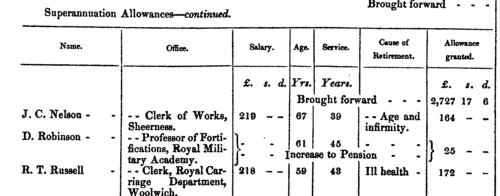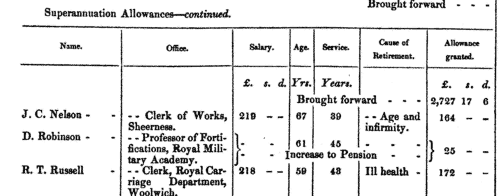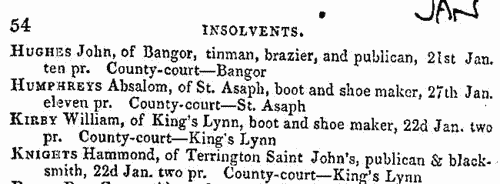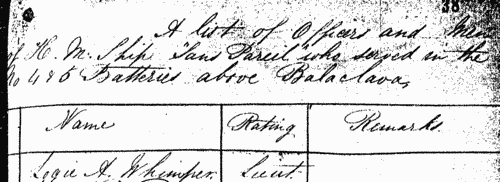Screech Surname Ancestry ResultsOur indexes 1000-1999 include entries for the spelling 'screech'. In the period you have requested, we have the following 55 records (displaying 11 to 20): Single Surname Subscription | | | Buying all 55 results of this search individually would cost £320.00. But you can have free access to all 55 records for a year, to view, to save and print, for £100. Save £220.00. More... |
These sample scans are from the original record. You will get scans of the full pages or articles where the surname you searched for has been found. Your web browser may prevent the sample windows from opening; in this case please change your browser settings to allow pop-up windows from this site. Inhabitants of Devon
(1830)
Pigot & Co.'s National Commercial Directory lists traders, farmers and private residents in the county.SCREECH. Cost: £6.00.  | Sample scan, click to enlarge

|  British merchant seamen
(1835-1836) British merchant seamen
(1835-1836)
At this period, the foreign trade of ships plying to and from the British isles involved about 150,000 men on 15,000 ships; and the coasting trade about a quarter as many more. A large proportion of the seamen on these ships were British subjects, and so liable to be pressed for service in the Royal Navy; but there was no general register by which to identify them, so in 1835 parliament passed a Merchant Seamen's Registration Bill. Under this act this large register of British seamen was compiled, based on ships' crew lists gathered in British and Irish ports, and passed up to the registry in London. Each seaman was assigned a number, and the names were arranged in the register by first two letters of the surname (our sample scan shows one of the pages for 'Sm'); in addition, an attempt was made to separate out namesakes by giving the first instance of a name (a), the second (b), and so on. But no effective method was devised to prevent the same man being registered twice as he appeared in a second crew list; moreover, the original crew lists were clearly difficult for the registry clerks to copy, and some of the surname spellings appear to be corrupted. A parliamentary committee decided that the system devised did not answer the original problem, and this register was abandoned after less than two years: but it is an apparently comprehensive source for British merchant seamen in 1835 to 1836. The register records the number assigned to each man; his name; age; birthplace; quality (master, captain, mate, 2nd mate, mariner, seaman, fisherman, cook, carpenter, boy &c.); and the name and home port of his ship, with the date of the crew list (usually at the end of a voyage). Most of the men recorded were born in the British Isles, but not all (for instance, Charleston and Stockholm appear in the sample scan). The final column 'How disposed of' is rarely used, and indicates those instances where a man died, was discharged, or deserted his ship during the voyage.SCREECH. Cost: £8.00.  | Sample scan, click to enlarge

| Deaths: Customs Officers: Stockton
(1847)
The annual return for 1847 of 'Allowances or Compensations granted as Retired Allowances or Superannuations in all Public Offices or Departments' lists new compensation allowances (usually for loss of office under reorganization), superannuation allowances (for retirement), and temporary allowances (for sickness or accident) arising during the year; and the cessation of such allowances by death (or occasionally because the individual has been re-employed, or the allowance has remained unclaimed for six years). The format of the returns varies from department to department, but generally the details of a new allowance give full name or surname and initials, office, age, length of service, affliction, and rate of allowance. The lists of deaths give full name or surname and initials, office, date of death, and the amount paid in the year. Throughout the death returns the column 'annual amount' means 'the amount actually paid out during 1847', rather than the yearly amount of the allowance.
SCREECH. Cost: £6.00.  | Sample scan, click to enlarge

| New Superannuation Allowances: Customs Officers: Stockton
(1847)
The annual return for 1847 of 'Allowances or Compensations granted as Retired Allowances or Superannuations in all Public Offices or Departments' lists new compensation allowances (usually for loss of office under reorganization), superannuation allowances (for retirement), and temporary allowances (for sickness or accident) arising during the year; and the cessation of such allowances by death (or occasionally because the individual has been re-employed, or the allowance has remained unclaimed for six years). The format of the returns varies from department to department, but generally the details of a new allowance give full name or surname and initials, office, age, length of service, affliction, and rate of allowance. The lists of deaths give full name or surname and initials, office, date of death, and the amount paid in the year. Throughout the death returns the column 'annual amount' means 'the amount actually paid out during 1847', rather than the yearly amount of the allowance.
SCREECH. Cost: £6.00.  | Sample scan, click to enlarge

| Insolvents imprisoned for debt in England and Wales
(1851)
Perry's Bankrupt and Insolvent Gazette, issued monthly, included brief notices of insolvents' estates surrendered to assignees. Each entry gives the surname and christian name of the insolvent, trade and address, followed by the name of the prison. This is the index to the names of the insolvents, from the issues from January to December 1851.SCREECH. Cost: £6.00.  | Sample scan, click to enlarge

| Insolvents in England and Wales
(1851)
Perry's Bankrupt and Insolvent Gazette, issued monthly, included lists of insolvencies and stages in the process whereby the insolvents petitioned for release from debtors' prison. The insolvent is generally referred to by name (surname first), address and trade. This is the index to the names of the insolvents, from the issues from January to December 1851.SCREECH. Cost: £6.00.  | Sample scan, click to enlarge

|  Sailors of H. M. S. Sans Pareil who fought at Balaclava
(1854) Sailors of H. M. S. Sans Pareil who fought at Balaclava
(1854)
Sebastopol in the Crimea was the great Russian naval arsenal on the Black Sea. A combined assault by British, French and Turkish troops resulted in the reduction of Sebastopol and led to the Treaty of Paris of 27 April 1856, guaranteeing the independence of the Ottoman Empire. By Admiralty Order the Crimea Medal was awarded to sailors and marines present during the campaign, between 17 September 1854 (the first landing at Eupatoria) and 9 September 1855 (when the allies secured Sebastopol). Her Majesty's Ship Sans Pareil (Sanspareil), an 81-gun screw steamer, took part in the assault. Four clasps to this medal were awarded to the men present in the actions at Sebastopol itself, Inkerman, Balaklave (Balaclava) and (the sea of) Azoff. The Russian troops attacked the British army 25 October 1854 at Balaclava, but were defeated with heavy loss. It was at this battle that the famous charge was made by the Light Brigade. Here we have the list of the men from the ship who served as part of the naval brigade in the number 4 and 5 batteries above Balaclava.SCREECH. Cost: £8.00.  | Sample scan, click to enlarge

|  Marines on H. M. S. Niger in the Crimean War
(1854-1856) Marines on H. M. S. Niger in the Crimean War
(1854-1856)
Sebastopol in the Crimea was the great Russian naval arsenal on the Black Sea. A combined assault by British, French and Turkish troops resulted in the reduction of Sebastopol and led to the Treaty of Paris of 27 April 1856, guaranteeing the independence of the Ottoman Empire. By Admiralty Order the Crimea Medal was awarded to sailors and marines present during the campaign, between 17 September 1854 (the first landing at Eupatoria) and 9 September 1855 (when the allies secured Sebastopol). This is the list of officers and men of the Marine Brigade borne by this ship and awarded the Crimea Medal. Her Majesty's Ship Niger, a 14-gun screw steamer sloop, took part in the assault. Four clasps to this medal were awarded to the men present in the actions at Sebastopol itself (September 1854 to September 1855), Inkerman (5 November 1854), Balaklave (Balaclava) (25 October 1854) and (the sea of) Azoff. In this list the column headed 'No. on Ship's Book' has been used to show for each man entitlement to the clasps for B(alaclava), I(nkerman) and/or S(ebastopol).SCREECH. Cost: £8.00.  | Sample scan, click to enlarge

|  Sailors and marines on H. M. S. Britannia in the Crimean War
(1854-1856) Sailors and marines on H. M. S. Britannia in the Crimean War
(1854-1856)
Sebastopol in the Crimea was the great Russian naval arsenal on the Black Sea. A combined assault by British, French and Turkish troops resulted in the reduction of Sebastopol and led to the Treaty of Paris of 27 April 1856, guaranteeing the independence of the Ottoman Empire. By Admiralty Order the Crimea Medal was awarded to sailors and marines present during the campaign, between 17 September 1854 (the first landing at Eupatoria) and 9 September 1855 (when the allies secured Sebastopol). The sailors' medals were mostly delivered to them on board ship in the course of 1856; the marines' medals were sent to their respective headquarters for distribution. The remarks as to distribution in this medal roll therefore give more specific information as to the whereabouts of the sailor recipients in 1856 than about the marines. Her Majesty's Ship Britannia, a 120-gun sailing ship, took part in the assault. Four clasps to this medal were awarded to the men present in the actions at Sebastopol itself, Inkerman, Balaklave (Balaclava) and (the sea of) Azoff, but the recipients of these clasps are recorded on separate rolls, not part of this index, but indexed on this site.SCREECH. Cost: £8.00.  | Sample scan, click to enlarge

|  Sailors and marines on H. M. S. Retribution in the Crimean War
(1854-1856) Sailors and marines on H. M. S. Retribution in the Crimean War
(1854-1856)
Sebastopol in the Crimea was the great Russian naval arsenal on the Black Sea. A combined assault by British, French and Turkish troops resulted in the reduction of Sebastopol and led to the Treaty of Paris of 27 April 1856, guaranteeing the independence of the Ottoman Empire. By Admiralty Order the Crimea Medal was awarded to sailors and marines present during the campaign, between 17 September 1854 (the first landing at Eupatoria) and 9 September 1855 (when the allies secured Sebastopol). The sailors' medals were mostly delivered to them on board ship in the course of 1856; the marines' medals were sent to their respective headquarters for distribution. The remarks as to distribution in this medal roll therefore give more specific information as to the whereabouts of the sailor recipients in 1856 than about the marines. Her Majesty's Ship Retribution, a 28-gun steam frigate, took part in the assault. Four clasps to this medal were awarded to the men present in the actions at Sebastopol itself, Inkerman, Balaklave (Balaclava) and (the sea of) Azoff, but the recipients of these clasps are recorded on separate rolls, not part of this index, but indexed on this site.SCREECH. Cost: £8.00.  | Sample scan, click to enlarge

|
Research your ancestry, family history, genealogy and one-name study by direct access to original records and archives indexed by surname.
|













